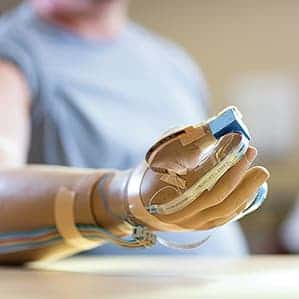Prosthetics have come a long way in recent years alone, mainly due to advancements in brain-machine interfaces. Incredibly articulated artificial limbs can now allow a disabled individual to move an artificial hand (with up to seven degrees of freedom!) and individual fingers just by thinking about the movement the person wants the limb to perform). While an artificial hand today may seem like a godsend to the bearer, at least compared to the complete lack of the limb or a traditional prosthetic alternative, it’s far from being the same as having a natural hand, very simply because you can’t feel. Sure you can grasp, hold, point, even shake hands, but you can’t feel anything while doing this.

Now, researchers at the Cleveland Veterans Affairs Medical Center and Case Western Reserve University reported they’ve devised an artificial hand that can relay back some sense of touch. We’ve presented haptic systems before, but this one works differently. Throughout the hand there are 20 sensitive hot spots, while implants connect these spots with nerve endings to relay back touch. We need to mention here that these sensitive spots continued to work even 18 months after installation, making for an important milestone since “electrical interfaces to nerve tissue can gradually degrade in performance,” according to the authors.
A firm hand-shake
Arguably, our dexterous hands are what allowed man to become the dominant species on Earth, as we could maneuver tools . Hands not only allow us to manipulate the physical, external world, but they also provide a sensory tool for perceiving reality around us. When you touch or grasp something with your hand you feel a myriad of stimuli that tell you a lot about the object you’re holding in your hand, from temperature, to texture, to pressure and more. Also, your hands can feel extremely subtle variations of all these parameters. With this in mind, you can imagine devising an artificial hand capable of mimicking a real hand is darn challenging. We’re getting there, though.
For instance, the artificial hand developed at Case Western operates on a feedback-loop similar to neural haptics. In fact, the artificial hand can not only relay simple contact, but texture and more complex pressure sensations. For instance, in the demonstrative video embedded below, a prosthesis wearer uses the artificial hand with “touch” activated and, while blindfolded, interacts with cherries. He is able to say how hard he pressed them and whether or not he believed he squished some of them.
It really looks very promising, and while it still is confined to the lab for research, the authors are confident something similar to this could become available on the market in the next decade. An estimated 1,715 soldiers suffered amputations in the wars in Iraq and Afghanistan, and along with thousands other sustaining amputations each year due to accidents or disease, could benefit from the artificial hand.
via TechnologyReview



